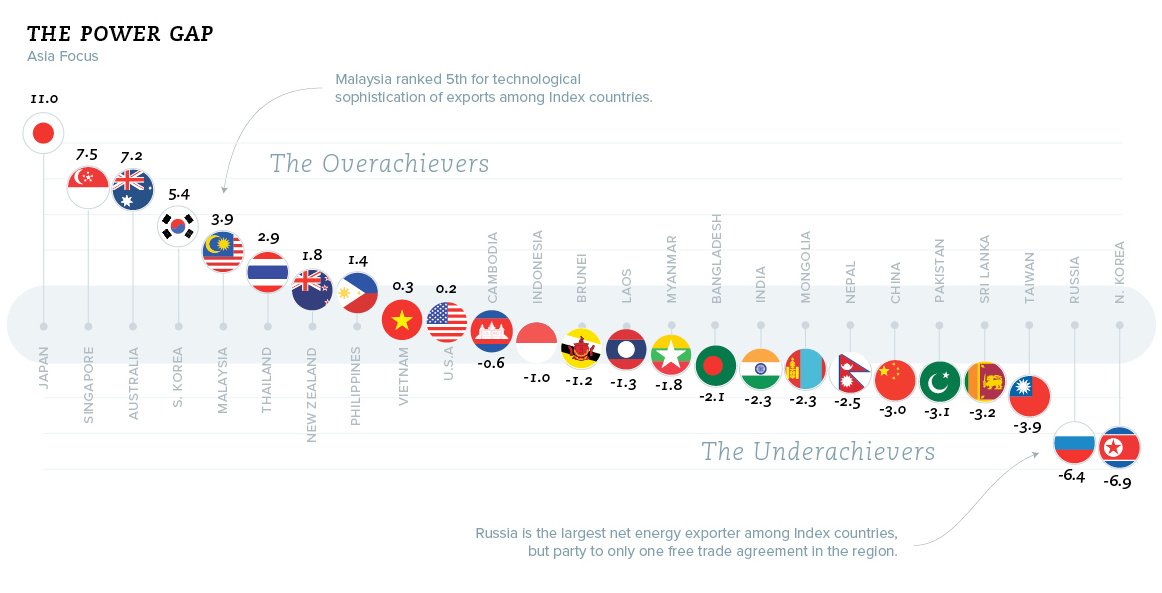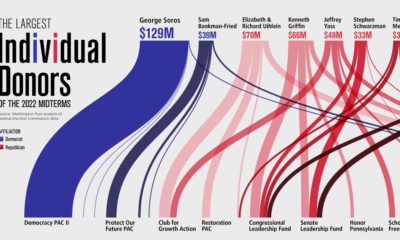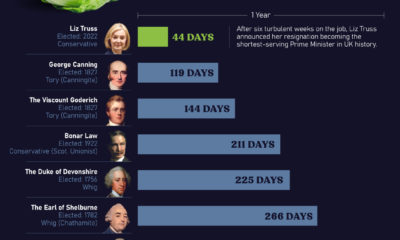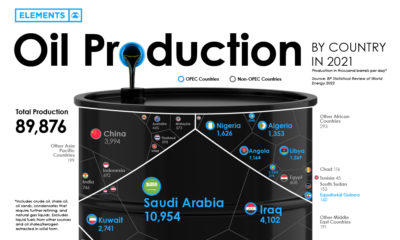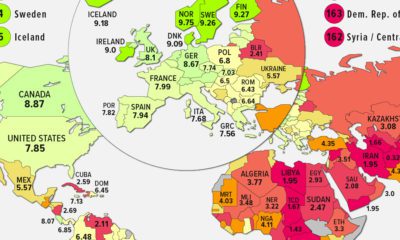They say the pen is mightier than the sword. However, what they often fail to mention is that the pen is even mightier when it comes with massive amounts of leverage, influence, and power backing it up on every stroke.
How to Win Friends and Influence Countries
Every country is interested in gaining influence, and earlier this week we showed you an interactive infographic from the Lowy Institute that compared the strength of Asian powers to the United States. Today’s chart uses the same data set, and it not only highlights the most influential countries in the Asian arena, but it also plots resources (i.e. the potential for power) of countries against their actual level of influence. The Lowy Institute calls this the “Power Gap” and it is intended to show whether a country is overperforming or underperforming in terms of fulfilling its expected level of influence on the region. Here are descriptions of the two measures which are used for the Power Gap: Resources: A score based on economic resources, military capability, resilience, and future trends, this measurement provides an assessment of a country’s material capabilities and robustness, which are requisite factors in the exercise of power. Influence: A score based on diplomatic influence, economic relationships, defense networks, and cultural influence, this measurement is used to assess a country’s level of influence on other countries in the Asian arena. Next, we’ll look at the actual numbers to see what we can learn.
Measuring Influence
Here’s how countries perform – as a reminder, this is based on the Asia Power Index, which is made up of countries in the Asia-Pacific region and the United States. In terms of absolute power, the U.S. and China top the list. Interestingly, Russia is only 5th place overall. The “Power Gap” partially seems to explain this, as Russia appears to have the biggest gap between its expected power and its actual power. The country has the second worst power gap at -6.4. Looking at the opposite end of the spectrum, it appears Japan, Singapore, and Australia are all punching above their weight in terms of influence. Meanwhile, Malaysia has the 5th best power gap, which may be unexpected for many. on Even while political regimes across these countries have changed over time, they’ve largely followed a few different types of governance. Today, every country can ultimately be classified into just nine broad forms of government systems. This map by Truman Du uses information from Wikipedia to map the government systems that rule the world today.
Countries By Type of Government
It’s important to note that this map charts government systems according to each country’s legal framework. Many countries have constitutions stating their de jure or legally recognized system of government, but their de facto or realized form of governance may be quite different. Here is a list of the stated government system of UN member states and observers as of January 2023: Let’s take a closer look at some of these systems.
Monarchies
Brought back into the spotlight after the death of Queen Elizabeth II of England in September 2022, this form of government has a single ruler. They carry titles from king and queen to sultan or emperor, and their government systems can be further divided into three modern types: constitutional, semi-constitutional, and absolute. A constitutional monarchy sees the monarch act as head of state within the parameters of a constitution, giving them little to no real power. For example, King Charles III is the head of 15 Commonwealth nations including Canada and Australia. However, each has their own head of government. On the other hand, a semi-constitutional monarchy lets the monarch or ruling royal family retain substantial political powers, as is the case in Jordan and Morocco. However, their monarchs still rule the country according to a democratic constitution and in concert with other institutions. Finally, an absolute monarchy is most like the monarchies of old, where the ruler has full power over governance, with modern examples including Saudi Arabia and Vatican City.
Republics
Unlike monarchies, the people hold the power in a republic government system, directly electing representatives to form government. Again, there are multiple types of modern republic governments: presidential, semi-presidential, and parliamentary. The presidential republic could be considered a direct progression from monarchies. This system has a strong and independent chief executive with extensive powers when it comes to domestic affairs and foreign policy. An example of this is the United States, where the President is both the head of state and the head of government. In a semi-presidential republic, the president is the head of state and has some executive powers that are independent of the legislature. However, the prime minister (or chancellor or equivalent title) is the head of government, responsible to the legislature along with the cabinet. Russia is a classic example of this type of government. The last type of republic system is parliamentary. In this system, the president is a figurehead, while the head of government holds real power and is validated by and accountable to the parliament. This type of system can be seen in Germany, Italy, and India and is akin to constitutional monarchies. It’s also important to point out that some parliamentary republic systems operate slightly differently. For example in South Africa, the president is both the head of state and government, but is elected directly by the legislature. This leaves them (and their ministries) potentially subject to parliamentary confidence.
One-Party State
Many of the systems above involve multiple political parties vying to rule and govern their respective countries. In a one-party state, also called a single-party state or single-party system, only one political party has the right to form government. All other political parties are either outlawed or only allowed limited participation in elections. In this system, a country’s head of state and head of government can be executive or ceremonial but political power is constitutionally linked to a single political movement. China is the most well-known example of this government system, with the General Secretary of the Communist Party of China ruling as the de facto leader since 1989.
Provisional
The final form of government is a provisional government formed as an interim or transitional government. In this system, an emergency governmental body is created to manage political transitions after the collapse of a government, or when a new state is formed. Often these evolve into fully constitutionalized systems, but sometimes they hold power for longer than expected. Some examples of countries that are considered provisional include Libya, Burkina Faso, and Chad.
